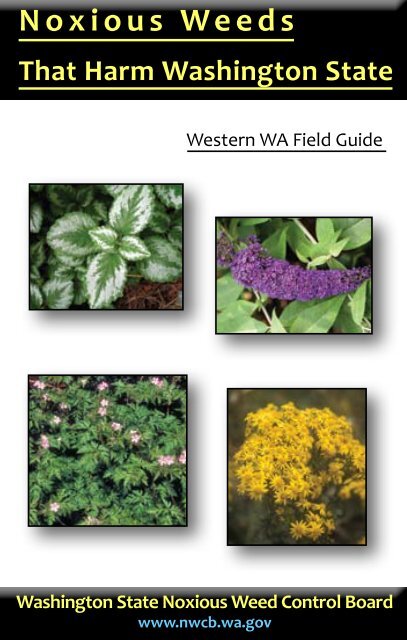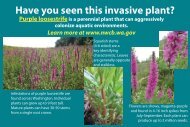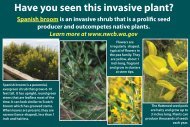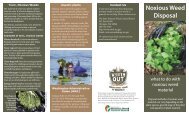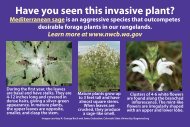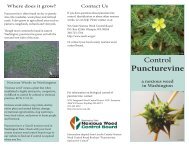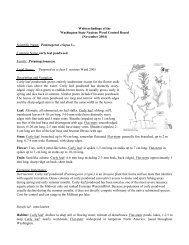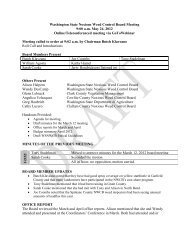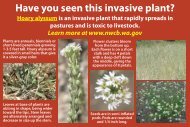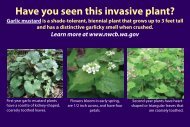Noxious Weeds That Harm Washington State
Noxious Weeds That Harm Washington State
Noxious Weeds That Harm Washington State
- No tags were found...
You also want an ePaper? Increase the reach of your titles
YUMPU automatically turns print PDFs into web optimized ePapers that Google loves.
<strong>Noxious</strong> <strong>Weeds</strong><strong>That</strong> <strong>Harm</strong> <strong>Washington</strong> <strong>State</strong>Western WA Field Guide<strong>Washington</strong> <strong>State</strong> <strong>Noxious</strong> Weed Control Boardwww.nwcb.wa.gov
Table of ContentsCommon Name Botanical Name Pagecommon reed Phragmites australis W-6yellow nutsedge Cyperus esculentus W-8spurge laurel Daphne laureola W-10orange hawkweed Hieracium aurantiacum W-12buffalobur Solanum rostratum W-14common fennel Foeniculum vulgare W-16gorse & Scotch broom Ulex europaeus, W-18Cytisus scopariussulfur cinquefoil Potentilla recta W-20tansy ragwort Senecio jacobea W-22yellow archangelLamiastrumW-24galeobdolonyellow hawkweed Hieracium caespitosum W-26garlic mustard Alliaria petiolata W-28giant hogweedHeracleumW-30mantegazzianumknotweeds Polygonum spp. W-32poison hemlock Conium maculatum W-34wild chervil Anthricus sylvestris W-36
Common Name Botanical Name Pagebutterfly bush Buddleja davidii W-38buglosses & blueweed Anchusa spp., Echium W-40vulgarepurple loosestrife Lythrum salicaria W-42flowering rush Butomus umbellatus W-44shiny geranium & Geranium spp. W-46herb-Robertknapweeds Centaurea spp. W-48policeman’s helmet Impatiens glandulifera W-50thistles: slenderflower & Carduus tenuiflorus & W-52CanadaCirsium arvensethistles: milk & Scotch Silybum marianum &Onopordum acanthiumW-54IntroductionWhat is a noxious weed?“<strong>Noxious</strong> weed” is the traditional, legal termfor invasive plants that are so aggressivethey harm our local ecosystems or disruptagricultural production. These plants crowdout the native species that fish and wildlifeW-1
depend on. They also cost farmers millions ofdollars in control efforts and lost production– and that can make the food we buy moreexpensive.The term “noxious weed” includes non-nativeinvasive plants, shrubs, and trees that growboth on land and in wetlands, lakes, shorelinesand streams.How do noxious weeds spread?About half of thenoxious weeds in<strong>Washington</strong> are“escapees” fromgardens, and thatexplains why somany of them arequite beautiful.Others came to<strong>Washington</strong> as“stowaways” onships, as seedsaccidentallyincluded in packing material, or on the wheelsor shoes of travelers. The more people travel– and the more globally connected our worldbecomes – the more we spread seeds and plantfragments from place to place.Sue Winterowd, Stevens County NWCBW-2
Why are there laws about noxious weeds?Weed laws establish all property owners’responsibility for helping to prevent and controlthe spread of invasive plants. Since plants growwithout regard to property lines or politicaljurisdictions, everyone’s cooperation is neededto combat them. City gardeners, farmers,public land owners, foresters, and ranchers allhave a role to play in this effort.<strong>Washington</strong>’s first noxious weed law waspassed in 1881 to combat the spread ofinvasive plants that threatened farmers’fields. For many decades, the agriculturalcommunity led efforts to combat the spread ofinvasive plants. More recently, people haverecognized the harm invasive plants cause tonative ecosystems and wildlife. For instance,when spotted knapweed spreads in mountainmeadows, it can reduce the native plants elkeat by 90%.<strong>Washington</strong>’s state weed law (RCW 17.10)established the <strong>State</strong> <strong>Noxious</strong> Weed ControlBoard, and authorized counties to establishCounty <strong>Noxious</strong> Weed Control Boards. ManyCounty <strong>Noxious</strong> Weed Control Boards arefinanced with a small assessment included inproperty tax statements.W-3
Class C noxious weeds are alreadywidespread in <strong>Washington</strong>. In some cases,counties may require property owners tocontrol them, but more often counties simplytry to educate residents about why controllingthem is a good idea. Often the county noxiousweed programs work with landowners withwidespread weeds to develop a long-termcontrol program incorporating all the toolsof an integrated pest management (IPM)program.For a complete list of <strong>Washington</strong> <strong>State</strong> noxiousweeds or an introduction to <strong>Washington</strong>’sweed laws go to www.nwcb.wa.gov orcall 360-725-5764.Also available for download are the popularGarden Wise booklets which illustrate noninvasive,alternative plants for your garden.W-5
common reedPhragmites australisIdentification: Common reed is a large perennialgrass with woody, hollow stems up to12 feet tall.The lance-shaped leaves are up to 16 inches longand 1.5 inches wide and will often twist to oneside in the wind. The flowerheads are dense, silky,brownish-purple plumes that can reach 16 incheslong. Bloom time is July to October. Commonreed has an extensive, creeping rhizome network.Impact: This robust grass species forms densecolonies in both freshwater and saline wetlandsand ditches. These stands alter hydrology,displace native vegetation, and degrade valuablewetland habitat.Control: Since rhizomes can produce new plants,care must be taken to prevent dispersal. Mowing,when timed correctly, can reduce populations.For large infestations, selective aquaticherbicides can be effective, with late-summerthrough fall applications appearing to be mosteffective.W-6
Rich Old, www.xidservices.comRich Old, www.xidservices.comRich Old, www.xidservices.comClass B <strong>Noxious</strong> Weed W-7
yellow nutsedgeIdentification: Yellow nutsedge is a perennialsedge that grows 6-30 inches tall. It has a 3-sidedstem that is bulb-like at the base, and brightgreen, stiff, grass-like leaves. Straw-colored togolden-brown flowers grow in a cluster of spikesthat originate from a single point, with threelong leaf-like bracts at the base. It producestubers at the rhizome tips.Impact: Yellow nutsedge is one of the mostproblematic perennial weeds of cultivatedfields in the Pacific Northwest. It aggressivelycompetes with crops, and tubers that invadepotato fields reduce crop quality. Tuber densitycan reach 12 million per acre in heavily infestedfields.Control: Use caution when removing yellownutsedge plants, as tubers break off easily whensoil is disturbed. Tilling at least every four weekscan reduce tuber reserves. Planting competitivecrops can help outcompete yellow nutsedge.Herbicides can suppress this noxious weed, butprevention of spread to new fields is best.W-8Cyperus esculentus
Class B <strong>Noxious</strong> Weed W-9
spurge laurelDaphne laureolaIdentification: Spurge laurel is a shade-tolerantevergreen shrub 1.5-5 feet tall with yellow tingedgray bark. Leaves are dark green and glossy.They are spirally arranged around the stem anddensest along branch tips. Inconspicuous, yellowgreenflowers are clustered at the base of theleaves and bloom in late winter or early spring.Fruits are bluish-black.Impact: Spurge laurel has escaped cultivation,primarily near urban areas where birds eat itsfruit and disperse the seeds into nearby forests.The shrub rapidly forms monotypic stands thatoutcompete native understory plants. Oakwoodland forests are at the greatest at risk.Control: Due to the irritating toxins in the sap,stem, leaves, and fruits, it is advisable to weargloves and other protective gear when handlingspurge laurel. Seedlings can be hand-pulled andsmall shrubs can be dug up. Larger shrubs canbe treated with a selective herbicide or cut belowsoil line. Herbicide applied to the cut stumpprevents sprouting.W-10
Yamhill County Soil & Water Conservation DistrictClass B <strong>Noxious</strong> Weed W-11
orange hawkweedHieracium aurantiacumIdentification: Orange hawkweed can easily beidentified by its brilliant orange flower clusterson the end of long, leafless stems up to 2 feet tall.Each dandelion-like flower is about 1 inch across.Leaves are long and taper to a point and growfrom the base of the plant. The stems, leaves, andflower buds are covered with small, bristly hairs.Stems exude a milky sap when broken.Impact: Like other non-native, invasivehawkweeds, orange hawkweed is an aggressivecompetitor that overwhelms pasture andrangeland plant species, and reduces forage forlivestock and wildlife. Infestations can becomeextremely dense, with the basal leaves forming athick carpet.Control: For small, scattered patches, thesimplest control is to hand-pull or dig up anddispose of plants and roots. Selective herbicidecontrol can be effective on large, well-establishedinfestations.W-12
Fran LuceroFran LuceroClass B <strong>Noxious</strong> Weed W-13
uffaloburIdentification: A member of the tomato family,buffalobur is an annual plant that reaches aheight between ½ to 2 feet. The flowers areabout 1-1½ inches across, with five yellow petals.The leaves are alternate and irregularly dividedinto 5-7 lobes. The entire plant is covered withstraight, yellow spines.Impact: Buffalobur is native to the Midwest,where it is highly aggressive and invasive inpastures and dry rangeland. It also hosts thedestructive Colorado beetle. Seeds of this plantoften contaminate other seed crops, and sobuffalobur plants occasionally appear beneathbird feeders and in gardens. Eradication ofbuffalobur is a high priority because it is still rarein <strong>Washington</strong>, and it is still possible to preventit from gaining a foothold here.Control: Isolated plants or small infestationscan be eradicated by hoeing or digging them out.Be certain to wear gloves. Selective herbicidescan also be effective.W-14Solanum rostratum
Rich Old, www.xidservices.comClass A <strong>Noxious</strong> Weed W-15
common fennelFoeniculum vulgareIdentification: Unlike the non-invasive annualbulbing fennel, common fennel is a very largeperennial herb that can grow from 4-10 feet tall.Alternate leaves are dark green or bronze withfine, feathery leaflets. It has flat-topped clustersof small, yellow flowers. It has a taproot thatcan be 10 feet long. All parts of the plant smelldistinctively like anise or licorice.Impact: Common fennel colonizes disturbedareas and grasslands, where dense stands outcompetenative plants. Already a problem incoastal California, common fennel is beginningto escape gardens and landscapes along rightsof-waysand shorelines in western <strong>Washington</strong>. Itposes an additional threat to our few remaininggrasslands.Control: Young plants can be hand-pulled andlarger plants can be dug out with a shovel, but besure to get the entire root. Do not mow if plantshave already set seed, since this will help spreadthe seeds. Selective herbicides can be effective onlarge infestations.W-16
Thurston County NWCBClass B <strong>Noxious</strong> Weed W-17
gorse / Scotch broomDescription: Gorse and Scotch broom areevergreen shrubs in the pea family with brightyellow flowers. Gorse is readily identifiable by itsprominent spiny thorns on mature stems insteadof leaves. Scotch broom has 5-angled stems anddeciduous leaves, each with three narrow leaflets.Gorse blooms early, in late February to April,while Scotch broom blooms from April to June.Impact: Both of these noxious weeds displacegrassland habitat, outcompete native andbeneficial plants, and shade out tree seedlingsin regenerating forests. They also pose a firehazard due to their volatile oils. Scotch broom isfar more abundant than gorse and is a familiarsight along western <strong>Washington</strong> highways whenit blooms.Control: Young plants can be hand-pulled, andtools such as Weed Wrenches and Extratigatorscan yank out even large shrubs. Herbicidesare most effective when applied directly to cutstems. Because seeds of both species can remainviable for 40+ years, long-term managementof infestations is necessary. Biocontrols areavailable for both species.W-18Ulex europaeus & Cytisus scoparius
sulfur cinquefoilPotentilla rectaIdentification: Sulfur cinquefoil is a perennialplant up to 3 feet tall. Palm-shaped leaves have5-7 leaflets that are covered in stiff hairs onboth the upper and lower surfaces and are finelytoothed. The flowers are pale yellow with 5 heartshapedpetals.Impact: Sulfur cinquefoil can form densestands that displace native and beneficialplants and grasses. Because this species is notpalatable to livestock and wildlife, infestationscan significantly reduce the forage value ofrangelands and pastures.Control: For small, scattered patches, thesimplest control is to hand-pull or dig up anddispose of plants and roots. Selective herbicidesprovide fair control of large, well-establishedinfestations, but treatments are more effectivewhen combined with other control techniques,such as planting competitive grasses.W-20
Rich Old, www.xidservices.comClass B <strong>Noxious</strong> Weed W-21
tansy ragwortDescription: Tansy ragwort is a biennial thatgrows 2-4 feet tall. Young plants form basalrosettes with dark green, ruffled leaves withreddish stems. Mature plants have dark greenleaves with deep lobes rounded at the tip. Daisylikeflowers are dime-sized, yellow with goldencenters, and typically have 13 petals.Impact: Tansy ragwort is toxic to cattle andhorses whether fresh or dry, causing irreversibleliver damage. It spreads aggressively and seedsprolifically, with seeds remaining viable in thesoil for over 10 years.Control: For small patches or isolated plants,hand-pull or dig plants with a shovel before theyflower and discard plants in the trash. Be sureto wear gloves. Do not mow - plants will just reflowerat a height shorter than the mover blade.For large infestations, selective herbicides canbe very effective. Biocontrols (insects that attackthis plant) are also available. Keep animals out ofinfested pastures.W-22Senecio jacobea
Rich Old,www.xidservices.comClass B <strong>Noxious</strong> Weed W-23
yellow archangelIdentification: Yellow archangel is a fastgrowing,herbaceous perennial that trailsalong the ground. The stem is square andhairy. Coarsely toothed leaves are distinctivelyvariegated with green and gray. Hooded flowersare small and yellow and are arranged in whorlson upright stems. Bloom time is brief and occursin April or May.Impact: This plant is commonly used in hangingbaskets and as a groundcover. Unfortunately,it easily escapes cultivation due to improperdisposal of garden cuttings or hanging baskets.It forms dense colonies in forests and parks andis becoming an increasing problem in western<strong>Washington</strong>.Control: Prevent new infestations by disposingof plant material in the trash - do not put it incompost piles. Yellow archangel can be handpulled,but care must be taken to remove all rootmaterial and follow-up monitoring is necessary.Herbicides can also be effective.W-24Lamiastrum galeobdolon
Nancy Ness,Grays Harbor NWCBClass C <strong>Noxious</strong> Weed W-25
yellow hawkweedHieracium caespitosumIdentification: Yellow hawkweed is anherbaceous perennial. Leaves are primarily basal- growing close to the ground from the baseof the plant. They are narrow, 4-6 inches long,and covered in hairs. Dandelion-like flowers areyellow, ¾ inches in diameter, and grow in clustersat the top of a leafless, hairy stem that exudesa milky white sap when broken. The flowerbracts of meadow hawkweed and several othernon-native, invasive hawkweeds are covered indistinctively dark, bristly hairs.Impact: Yellow hawkweed reproduces by seed,stolons, and rhizomes and is an aggressivecompetitor in mountain meadows, rangeland,and may even invade cultivated fields. It isunpalatable and crowds out more desirableforage. There are several other yellow-floweredhawkweeds on the noxious weed list. Learn moreabout them at www.nwcb.wa.gov.Control: Small infestations may be hand-pulledor dug out, but the entire plant must be removedsince it can resprout. For larger infestations,selective herbicides can be effective.W-26
King County NWCBKing County NWCBRich Old,www.xidservices.comClass B <strong>Noxious</strong> WeedW-27
garlic mustardAlliaria petiolataDescription: Garlic mustard is a biennial plantthat has a distinctive garlic odor when crushed.During the first year, the plant forms a basalrosette of kidney-shaped leaves. The second year,the stem grows up to 3 feet tall, and the leavesare heart-shaped or triangular and coarselytoothed. Bloom time is early spring, and theflowers are white with four petals.Impact: This aggressive, shade-tolerant plantcan completely dominate forest floors anddisplace native species. It releases compoundsinto the soil that prevent other plants fromgrowing. Fruits can eject the tiny black seedsover ten feet, and the seeds are also dispersed byanimals, boots, equipment, and mulch.Control: Contact your county noxious weedcontrol board if you think you have seen thisplant. Pull up plants - including the roots - beforethey finish flowering and discard them in thetrash. Selective herbicides can be effective forlarge populations. Check boots, clothing, andequipment before leaving a garlic mustard site.W-28
Fran LuceroFran LuceroKing County NWCBVicky Nuzzo, Natural Areas Consultants, Bugwood.orgClass A <strong>Noxious</strong> Weed W-29
giant hogweedHeracleum mantegazzianumIdentification: Giant hogweed is a member ofthe parsley family that can grow up to 15 feettall. Its hollow stem is 2-4 inches in diameter,hairy, and has dark, purplish blotches. Theumbrella-like, flat-topped flowerhead can reacha diameter of two feet, and consists of smallwhite flowers arranged in clusters. The leavesare compound and huge – 2 to 5 feet wide – withjagged edges.Impact: Giant hogweed is a public hazard,as the plant exudes a clear watery sap whichsensitizes the skin to sunlight. This can resultin severe burns, causing blistering and scarring.It also forms dense canopies, outcompetesnative species, and increases soil erosion alongstreambanks.Control: Always wear protective clothing andavoid getting sap on skin. If plants are blooming,cut and bag flowerheads and put them inthe trash. Plants can be dug out, but be sure toremove all of the root stock. Selective herbicidescan be very effective.W-30
Class A <strong>Noxious</strong> Weed W-31
knotweedsPolygonum sachalinense, P. cuspidatum,Identification: The four knotweed species -giant, Japanese, Bohemian, and Himalayan - aretall, shrub-like, perennial, herbaceous plants.Stems often grow to over 10 feet tall and aresegmented and hollow, resembling bamboo.Knotweeds form dense colonies that sprout inApril, and bear clusters of small white flowers inlate summer. Each species produces differentlyshaped leaves, ranging from heart-shaped toarrow-shaped to long and slender.Impact: The knotweeds’ greatest impact is alongstreams and in riparian areas where they cancompletely displace native vegetation, erodestream banks, and change the nutrient cycleat the expense of salmon and other animals.Knotweed roots can grow so vigorously that theyerupt through blacktop and damage foundationsand other infrastructure.Control: Knotweed’s extensive roots andvigorous growth makes it extremely difficult tocontrol. Although small patches can be dug up,it may take several years to eradicate, and moststands require repeated applications of herbicideover several years. County noxious weed controlboards can provide advice and assistance.W-32
P. bohemicum, and P. polystachyumSkamania County NWCBIsland County NWCBTim Miller,WSU-NWRECClass B <strong>Noxious</strong> <strong>Weeds</strong> W-33
poison hemlockConium maculatumIdentification: This biennial member of theparsley family can grow up to 8 feet tall. Small,white, 5-petaled flowers grow in 4-inch clusterson stalks that radiate out like umbrella spokes.Leaves are dark glossy green and fernlike. Thestem is smooth and hollow with distinctivepurple splotches. Crushed leaves also have aunique musty odor.Impact: All parts of the plant are extremelytoxic to humans and livestock. Accidentalpoisonings have occurred when the plants weremistaken for parsley, parsnip, or wild carrot.Poison hemlock easily colonizes roadsides, vacanturban lots, pastures, and waterways.Control: Always wear gloves when handling thispoisonous plant. Selective herbicides are effectiveon this noxious weed. Because poison hemlockfoliage remains toxic after drying, it is critical todispose of it in the trash.W-34
Class B <strong>Noxious</strong> Weed W-35
wild chervilIdentification: Wild chervil is a biennialmember of the parsley family that can grow 1-4feet tall. Stems are hollow, noticeably ridged, andlower portions of the stem are covered in soft,felt-like hairs. Leaves are fernlike and slightlyhairy, especially the undersides. Flowers arewhite and arranged in clusters on stalks arrangedlike umbrella spokes. Bloom time begins as earlyas March. Look for rod-shaped black fruits atmaturity.Impact: Wild chervil is highly adaptable and willgrow in almost any type of soil. It forms denseinfestations that outcompete native plants andreduce habitat quality for wildlife. It spreadsrapidly along roadsides and other rights-of-way.Control: For small patches, dig up and disposeof plants, being careful to remove the taproot.Selective herbicides can be effective, especiallywhen controlling large infestations. Tillingplants into the soil, followed by seeding withcompetitive grasses, can control wild chervil.W-36Anthricus sylvestris
Sue Winterowd, Stevens County NWCBClass B <strong>Noxious</strong> Weed W-37
utterfly bushBuddleja davidiiIdentification: Butterfly bush is a deciduousshrub with arching branches that can reach aheight of 15 feet. It has showy flower spikes 4-10inches long, consisting of numerous, bell-shapedflowers that are often purple with an orangecenter. Leaves are 4-10 inches long, lanceshaped,oppositely arranged, finely toothed alongthe edges, and have fuzzy whitish undersides.Impact: Butterfly bush has tiny seeds that arespread far and wide by the wind. It colonizesroadsides, freeway medians, and disturbedareas, but its greatest impact comes when itspreads to stream banks, where it displacesnative vegetation - changing stream habitat, andreducing food supplies for native butterfly larvaeand other animals.Control: If you have butterfly bush on yourproperty, prevent the plant from establishingelsewhere by deadheading flowerheads beforethey set seed. Seedlings can be hand-pulled andadult plants dug up. Herbicide applied to foliageor cut stems can help reduce infestation.W-38
Class B <strong>Noxious</strong> Weed W-39
annual buglosscommon buglossblueweedFran LuceroSue WinterowdFran LuceroClass B <strong>Noxious</strong> <strong>Weeds</strong>W-41
purple loosestrifeIdentification: Purple loosestrife is a long-livedperennial, 6-10 feet tall. It has small, purpleto-magentaflowers with 5-6 petals arranged inupright flower spikes. Leaves are lance-shapedand either opposite or whorled in threes. Theleaves are stalkless and clasp the stem, which isdistinctively square in cross-section.Impact: Purple loosestrife displaces large areasof riparian and wetland native plants needed bywaterfowl and other wildlife for food, nesting,and groundcover. This invasive wetland specieschanges the nutrient cycle, affecting the foodweb. It also clogs irrigation canals and drainageditches.Control: Small patches can be dug up anddiscarded. Cutting alone will not control purpleloosestrife because of its extensive and vigorousroot systems. Because one plant is capableof producing 2 million seeds, flowers need tobe disposed of properly along with roots andstem fragments, which can resprout. For largeinfestations, selective, aquatic herbicides can beeffective, but a special permit is required. Severalbiocontrol insects are also available.W-42Lythrum salicaria
King County NWCBClass B <strong>Noxious</strong> Weed W-43
flowering rushIdentification: Flowering rush is a freshwaterperennial, which can grow either as a submersedor emergent plant. The leaves are fleshy andtriangular in cross-section, growing either below,above, or floating on the water surface. Flowerstalks, when present, are usually taller than theleaves and can reach up to 3 feet above the watersurface. Each flower stalk bears a single clusterof white to pink flowers at the tip, arranged likeumbrella spokes.Impact: Flowering rush rapidly colonizeswetlands, lake shorelines, and slow-movingrivers. It forms dense stands in previouslyunvegetated areas, which can reduce recreationalactivities such as swimming, boating, andfishing. This species also clogs unlined irrigationcanals and drainage ditches.Control: Flowering rush can be difficult tocontrol, so if you find it, contact your countynoxious weed control board. For smallinfestations it may be effective to cut belowwater surface several times during the summermonths. Isolated plants can be dug up anddisposed of, but be sure to include all rhizomes.Herbicides labeled for aquatic use are alsoavailable, but a special permit is required.W-44Butomus umbellatus
Ben LeglerBen LeglerBen LeglerClass A <strong>Noxious</strong> Weed W-45
shiny geranium/herb-RobertIdentification: Shiny geranium is a smallwinter annual. Stems are hairless and oftenhave a reddish tinge. Leaves are shiny, dividedinto 5-7 lobes, and sparsely covered with stiffhairs. The flowers have 5 bright pink petals, andeach of the 5 green sepals (beneath the petals)has a distinctive ridge. Herb-Robert is also anannual. It’s covered in short, glandular hairs andproduces a musky odor when crushed. Leaves arefern-like and bright green. The flowers also have5 bright pink petals and the sepals are burgundyand hairy.Impact: Both invasive geranium species are mostproblematic in forests. They spread quickly andcan dominate forest floors, displacing nativeherbaceous plants. While herb-Robert alreadyhas spread throughout western <strong>Washington</strong>,shiny geranium is a new invader with a verylimited distribution.Control: Both species have shallow root systems,and small infestations can be easily hand-pulled,ideally before they flower. Dispose of plantsin the garbage, not the compost. Selectiveherbicides can be effective for larger infestations.W-46Geranium lucidum & G. robertianum
shiny geraniumBen Leglershiny geranium (left) &herb-Robert (right)herb-RobertBen LeglerClass A & B <strong>Noxious</strong> <strong>Weeds</strong>W-47
knapweeds: spotted, diffuse, & meadowCentaurea stoebe, C. diffusa, & C. jacea x nigraIdentification: These members of the thistlefamily range from 2-5 feet tall, are spineless, andbear flowerheads with showy petals atop roundor egg-shaped bases. Leaves are small, lobed,and often bluish-green. All three species start asbasal rosettes in the spring. Spotted and meadowknapweed are perennials with stout taproots andpinkish-purple flowers. Diffuse knapweed is abiennial with white to purple flowers and smallspines covering the base of the flower.Impact: Invasive knapweeds rapidly spread alongrights-of-way and colonize meadows, rangeland,prairies, and open forests. They quickly crowdout native and desirable plants, dramaticallyreducing available forage and habitat forlivestock and wildlife.Control: Knapweed species are prolific seedproducers, so preventing the flowers from goingto seed is critical. Hand-pulling or digging canbe effective for small patches. Mowing is not agood option, because taproots can resprout. Forlarge infestations, both selective herbicides andbiocontrol are very effective options. Revegetatewith desirable species to provide competition.W-48
spotted knapweedSpokane County NWCBdiffuse knapweedRich Old,www.xidservices.comOkanogan County NWCBmeadow knapweedClass B <strong>Noxious</strong> <strong>Weeds</strong> W-49
policeman’s helmetImpatiens glanduliferaIdentification: Policeman’s helmet is an annualspecies with a smooth, hollow, purple-tingedstem ranging from 3-10 feet tall. Leaves areoval-shaped, coarsely toothed, and are eitheroppositely arranged or whorled three to a node.The pale pink or purplish flowers resemble theshape of an English policeman’s helmet.Impact: A garden escapee, this prolific, selfseedingplant is colonizing lowland riparianareas, which include moist forests, streambanks,and roadside thickets, where it dominates nativeplant communities.Control: Do not distribute seeds at garden groupexchanges, as this is a quarantined plant species.Policeman’s helmet has a shallow root system,so this plant pulls easily. Selective herbicidescan be effective if applied prior to flowering.Because seeds in the ground can remain viablefor two years, follow up monitoring and controlis recommended.W-50
Fran LuceroClass B <strong>Noxious</strong> Weed W-51
thistles: slenderflower & CanadaIdentification: Both thistle species are spinyand have clusters of pinkish-purple flowers.Slenderflower thistle is an annual that canreach 6 feet tall. Stems have a fringe of spiny,leaf-like wings. Spiny leaves are lobed, and arewhite underneath with dense, wooly hairs.Flower clusters consist of 5-20 blossoms.Canada thistle is a perennial reaching 1-4 feettall. Leaves are spiny, lobed, and shiny. It hassmall, weakly spined flowerheads, and seed headsform cottony tufts.Impact: Like other invasive thistles, thesespecies reduce forage quality of rangeland andpastures. Dense infestations of Canada thistlecan severely damage croplands.Control: For small patches, dig up and discardslenderflower thistle before flowers set seed.Selective herbicides can be effective for largerpopulations. Canada thistle’s extensive rootsystem produces numerous shoots, makingcontrol difficult. For small infestations, frequenttilling or mowing can be effective. Largerinfestations may be more effectively controlledwith selective herbicides or with biocontrol.W-52Carduus tenuiflorus & Cirsium arvense
slenderflower thistle - Class A noxious weedCanada thistle - Class C noxious weedClass A & C <strong>Noxious</strong> <strong>Weeds</strong>W-53
thistles: milk & ScotchSilybum marianum & Onopordum acanthiumIdentification: Milk thistle is a large winterannual or biennial ranging 2-6 feet in height. Ithas distinctive white marbling on its shiny greenleaves. Purple flowerheads are 2 inches wide withspine-tipped bracts. Scotch thistle is a biennialthat can grow to 10 feet tall. The entire plantis covered in felt-like hairs, giving it a silveryappearance. Leaves are long and wide, with thebasal leaves reaching 2 feet long. Flowerheads areup to 2-inches wide and are covered in spines.Impact: Both species form dense stands inpastures and rangelands, reducing forage forlivestock and wildlife and creating impenetrablethickets. Ingestion of milk thistle by grazinganimals causes nitrate poisoning, which can belethal.Control: Digging before flowers set seed caneffectively control these thistles. Mowing canprevent seed production but does not reduceinfestations. Selective herbicides can be used totreat larger infestations. Goats will graze Scotchthistle.W-54
milk thistle - Class A noxious weedScotch thistle - Class B noxious weedSue WinterowdSpokane County NWCBSue WinterowdClass A & B <strong>Noxious</strong> <strong>Weeds</strong>W-55
How can people help prevent andcontrol invasive noxious weeds?• Be careful what you plant. Since half ofall our noxious weeds are escapees fromgardens, ask questions before you buyplants or seeds. The <strong>State</strong> <strong>Noxious</strong> WeedControl Board can send you a publication(also available online atwww.nwcb.wa.gov) called GardenWise thatlists alternatives to common garden plantsknown to be invasive.• Be careful when you travel. Seeds ridealong in wheels, stick to your shoes, boots,clothing and pets. Take care not to takeinvasive plant seeds with you when you gohiking.• Clean your boat thoroughly between trips.Aquatic invaders are spread by even thesmallest plant fragments.• If you have invasive plants on yourproperty, do your part to control oreradicate them. If you need help or advice,contact your County Weed Board.• Volunteer to participate in weed pulls andnative plant restoration projects. Manyorganizations sponsor these events.
Production CreditsContributors: Alison Halpern, Jill Severn,Tim Miller, Bridget Simon, Angela Celestine,<strong>Weeds</strong> Cross Borders, Rick Johnson, SashaShawDesign: Cindy OrrPhotos: All photos not credited are fromthe <strong>Washington</strong> <strong>State</strong> <strong>Noxious</strong> WeedControl Board, and may be reproduced withpermission.For more information call (360) 902-2082 ore-mail noxiousweeds@agr.wa.govNative Deer Fern
Protecting <strong>Washington</strong>’s resourcesStaircase Trail, Lilliwaup, WAphoto by Jill Severn<strong>Washington</strong> <strong>State</strong> <strong>Noxious</strong> Weed Control Board1111 <strong>Washington</strong> Street (P.O. Box 42560)Olympia, WA 98504360-725-5764PUB 820-264W (N/6/09)


